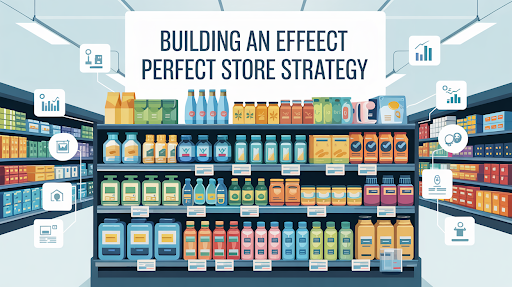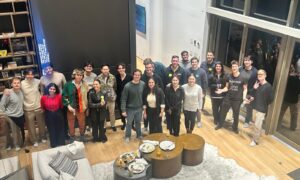For Consumer Packaged Goods (CPG) brands, maintaining optimal product availability and visibility is key to capturing consumer attention and driving sales. A “Perfect Store” goes beyond just having products on the shelf — it’s about creating an environment where every product is strategically placed, visible, and easily accessible to the consumer.
The importance of on-shelf visibility cannot be overstated, especially considering that leading retailers in the United States spend a staggering $7 billion annually just on manually monitoring shelf availability and product-facing compliance. With such a significant investment in keeping shelves stocked and organized, CPG brands must refine their strategies to ensure both efficiency and impact.
In this article, we will explore how to build an effective perfect store strategy that enhances on-shelf visibility, optimizes product placement, and ensures seamless execution across multiple retail locations.
Understanding the Current Retail Landscape
Retail is evolving rapidly, with shifting consumer expectations, increased competition, and a growing need for technological integration. For CPG brands, this means constantly adapting to new challenges, such as stockouts and misplaced products, while ensuring planogram compliance. The traditional methods of store execution, though still effective in some areas, have limitations when it comes to scalability and accuracy.
Modern retail environments are flooded with vast amounts of real-time data that can help overcome these challenges. However, many CPG brands struggle to utilize this data effectively to track on-shelf availability, compliance, and pricing. This is where a comprehensive, data-driven approach to building a Perfect Store can provide a significant edge.
Key Components of a Perfect Store Strategy
The Perfect Store involves more than just the right product on the right shelf at the right time. A successful strategy incorporates several key components that collectively drive higher sales and improved brand presence.
1. Product Assortment Optimization
The first step in executing a Perfect Store is ensuring that the right products are available at the right time. Using data insights from sales trends, customer behavior, and market analysis, CPG brands can optimize their product assortment. This means not just stocking products based on popularity but also considering factors like regional preferences, seasonal demand, and even promotional periods.
By leveraging real-time data to determine which products should be featured prominently, brands can ensure that their store assortment aligns with consumer needs, improving the likelihood of conversion at the shelf.
2. Strategic Shelf Placement
One of the most important factors in improving on-shelf visibility is shelf placement. Planograms, which detail the optimal arrangement of products on store shelves, are essential to maintaining product visibility and maximizing shelf space efficiency.
A strategic approach to shelf placement involves aligning products in ways that maximize consumer interaction. For example, best-selling products should be placed at eye level to increase visibility, while complementary products should be placed nearby to encourage impulse purchases. These planograms should be regularly updated based on real-time data and consumer shopping patterns to ensure maximum effectiveness.
3. Pricing and Promotion Excellence
Competitive pricing and well-executed promotions can significantly influence sales. Ensuring that products are priced competitively and that in-store promotions are visible and compelling is key to creating a Perfect Store. By integrating AI-driven tools to monitor pricing and promotional setups, CPG brands can ensure that they are meeting both retailer and customer expectations.
Moreover, tracking promotional compliance ensures that the store is running the right campaigns in the right locations. This consistency across all stores will help build a seamless brand experience and ultimately drive higher sales.
4. Retailer Collaboration and Compliance
It is vital to work closely with retailers to ensure compliance with product placement and promotional strategies. Regular audits and feedback loops help ensure that store executions meet the standards outlined in the planograms.
Using AI-based compliance monitoring tools like ParallelDots’ ShelfWatch allows CPG brands to track in-store conditions in real time. This tool helps quickly identify any discrepancies in shelf execution, ensuring that corrective actions can be taken immediately to maintain a perfect store environment.
Leveraging Technology for Enhanced Execution
For CPG brands, the use of advanced tools like AI, data analytics, and real-time reporting is crucial for maintaining a competitive edge. By integrating these technologies, CPGs can optimize store operations, improve compliance, and enhance overall retail performance. Here’s how technology, particularly the solutions provided by ParallelDots, helps in enhancing store execution:
1. Real-Time Shelf Monitoring and Stock Availability
One of the core challenges for CPG brands is maintaining product availability across multiple retail locations. With ParallelDots’ ShelfWatch, brands gain real-time visibility into store conditions, including product placement, stock levels, and planogram compliance.
Using image recognition technology, ShelfWatch automates shelf audits, helping brands identify stockouts or misplaced items instantly. This reduces the manual effort involved and allows for quick actions to replenish stock, ensuring that customers always find what they need.
2. Data-Driven Insights for Strategic Decision-Making
ParallelDots’ data analytics tools offer a powerful solution to help CPG brands track critical performance metrics, such as on-shelf availability, share of shelf, and planogram compliance. Analyzing this data allows brands to identify trends, spot gaps, and optimize their in-store execution strategies. This helps brands stay ahead of the competition by making informed decisions based on real-time information, improving operational efficiency, and driving sales growth.
3. Streamlined Field Team Operations
ParallelDots’ mobile solutions enhance the efficiency and productivity of field teams. With AI-powered apps, sales representatives can capture store conditions, report issues, and receive immediate feedback. This mobile integration eliminates delays, enabling field teams to resolve problems on the spot, whether it’s a pricing issue, product misplacement, or promotional discrepancy. The ability to act quickly ensures that stores stay compliant with the brand’s standards and that no opportunity is missed.
4. Automated Planogram Compliance
Adhering to planograms is vital to ensuring that products are displayed optimally and attract consumer attention. ParallelDots’ technology helps automate planogram compliance checks, using image recognition to verify that products are correctly placed according to the brand’s guidelines. This technology ensures uniformity across multiple locations, maintaining consistency and enhancing the overall shopping experience.
5. Enhanced Promotional Execution
Promotions are a key factor in driving sales, but they need to be executed flawlessly. With ParallelDots’ tools, CPG brands can track promotional compliance, ensuring that signage is in place, products are correctly displayed, and discounts are applied as planned. This real-time tracking helps brands maximize the effectiveness of their campaigns, ensuring that promotions reach their full potential and contribute to increased sales.
By leveraging ParallelDots’ cutting-edge technology, CPG brands can achieve seamless in-store execution, improve store compliance, and ultimately enhance their retail performance. These tools not only streamline operations but also provide valuable insights that drive smarter decision-making and better outcomes in the retail environment.
In the next section, we’ll explore how measuring the impact of perfect store execution can directly influence a brand’s sales growth.
Measuring Success and Continuous Improvement
Implementing a perfect store strategy is not a one-time effort but an ongoing process that requires continuous monitoring and refinement. To ensure that the strategy is delivering the desired outcomes, CPG brands need to measure their success through the tracking of key performance indicators (KPIs).
These KPIs provide insights into how well the in-store execution is performing and highlight areas for improvement. By consistently tracking these metrics and making data-driven adjustments, CPG brands can achieve sustained growth and operational excellence.
1. Key Performance Indicators (KPIs) to Track
KPIs are essential for assessing how effective your perfect store strategy is in achieving its goals. For CPG brands, KPIs offer measurable data on critical aspects such as product availability, visibility, and customer engagement. These metrics help determine if the store execution strategy is performing as expected and where improvements are needed. The following KPIs are crucial for CPG brands to track:
- On-Shelf Availability Rates
This KPI measures how often products are available and in stock on the shelves. A key indicator of store execution success, maintaining high on-shelf availability ensures that products are accessible to customers and prevents missed sales opportunities. - Planogram Compliance Percentages
Planogram compliance measures how well stores follow the predefined layout of products. This KPI is vital because it directly impacts product visibility, customer experience, and sales performance. Monitoring compliance ensures that brands maintain consistency across all store locations. - Sales Lift During Promotions
Tracking the increase in sales during promotional events helps measure their effectiveness. This KPI can indicate how well promotions are executed and whether they are driving the intended increase in customer engagement and sales. - Consumer Engagement Metrics
Consumer engagement with promotional displays and product placement is a critical KPI. By analyzing how customers interact with in-store promotions and displays, brands can gauge how compelling their offerings are and make adjustments to optimize engagement.
These KPIs provide valuable insights into store execution and allow CPG brands to fine-tune their strategies for better results.
2. Feedback Mechanisms
Feedback from both retailers and consumers plays a vital role in the continuous improvement of a perfect store strategy. For CPG brands, staying connected with retail partners is essential for identifying execution challenges early and making necessary corrections quickly. Additionally, consumer feedback gives brands direct insights into how their products and promotions are perceived and whether they meet customer expectations.
The incorporation of real-time feedback into their strategy allows CPG brands to create a responsive and agile approach to in-store execution. This feedback loop will enable brands to address issues before they escalate, ensuring that execution remains aligned with brand standards. Real-time data insights combined with retailer and consumer feedback can empower brands to enhance in-store experiences and drive higher sales.
- Case Study: Implementing a Perfect Store Strategy
A real-world example of a perfect store strategy in action comes from a leading personal care brand. By utilizing ParallelDots’ ShelfWatch, the brand was able to monitor store compliance in real-time, allowing them to identify stores where execution fell short of standards quickly.
With this real-time data, the brand rectified compliance issues within hours, resulting in a significant sales boost and improved visibility. Additionally, by equipping field teams with mobile solutions, the brand was able to reduce audit times by 60%, improving operational efficiency and allowing for faster corrective actions.
For a detailed look at this success story, read the full case study here: Personal Care Company Case Study.
Tracking the right KPIs and incorporating feedback into your strategy allows CPG brands to improve and adapt their retail execution for greater success continuously. However, several common challenges face CPG brands when implementing these strategies.
In the next section, we will explore these challenges and discuss effective solutions to overcome them, ensuring that your perfect store strategy remains successful in the long term.
Addressing Common Challenges
Implementing a perfect store strategy offers substantial benefits, but it also comes with a set of challenges that CPG brands must overcome to ensure success. However, with the right approach and tools, brands can effectively address these obstacles and continue driving retail performance. Let’s explore some of the most common challenges and practical solutions that can help overcome them.
1. Resource Constraints
Many CPG brands face significant resource constraints when attempting to implement a perfect store strategy. These limitations often involve budget cuts, especially in retail operations, which can make investing in high-tech tools and personnel challenging. However, by focusing on high-impact stores and adopting scalable AI-driven solutions, brands can mitigate costs without compromising effectiveness.
For example, brands can use tools like ParallelDots’ ShelfWatch, which provides real-time shelf data and insights, allowing companies to prioritize stores with the highest sales potential. This targeted approach ensures that brands can maximize their ROI while adhering to budgetary limits. Scalable technologies also allow for gradual implementation, making it easier to scale up as the business grows or as additional resources become available.
2. Data Integration Issues
One of the most challenging aspects of implementing a perfect store strategy is integrating data from multiple sources. CPG brands often rely on disparate systems, which can lead to fragmented insights that are difficult to manage and act upon. This data fragmentation hampers the ability to make real-time, data-driven decisions.
To address this, brands can turn to unified platforms like ParallelDots’ ShelfWatch, which consolidates data from multiple sources into a single, accessible dashboard. This integration streamlines data analysis, helping brands gain actionable insights in real-time. By bringing all relevant data together, such platforms allow for quicker decision-making and more accurate tracking of KPIs, such as on-shelf availability and planogram compliance.
3. Retailer Resistance
Retailer resistance can often pose a significant hurdle when CPG brands look to implement new strategies. Retailers may be hesitant to adopt new processes or tools, especially if they require significant changes to store operations or additional training. To overcome this resistance, CPG brands must invest in open communication and collaborative partnerships with retailers.
Additionally, providing retailers with real-time data insights and demonstrating the impact of new strategies on their operations can help secure buy-in and smooth the path for implementation. Brands should offer support throughout the rollout process to ease the transition and ensure that retailers feel confident about the changes being made.
Conclusion
Achieving perfect store execution in today’s competitive retail landscape is not just a luxury; it’s the difference between staying relevant or falling behind. CPG brands must ensure products are always available, correctly placed, and aligned with promotional goals. However, technology is key to making this happen consistently across multiple locations.
ParallelDots provides cutting-edge AI tools, like ShelfWatch, to streamline real-time shelf monitoring, ensure planogram compliance, and optimize retail operations. Our solutions empower CPG brands to stay ahead, improve store execution, and ultimately drive higher sales.
Curious about how ParallelDots can elevate your store performance? Book a demo today and experience how our solutions can help you achieve flawless execution and boost your retail impact!





























